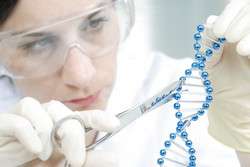Gene editing is on a roll, but is it safe to clear the way?

What do disease-resistant pigs and the eradication of malaria have in common? These seemingly distant topics, both of which were extensively covered in the press this week, are actually just early glimpses of gene editing's overwhelming potential.
On one hand, a UK-based animal genetics firm was able to breed pigs totally immune to PRRSv, a previously incurable porcine syndrome that costs farmers hundreds of millions of euros per year. At the same time another team of researchers, also based in the UK, engineered a genetic change in malaria-transmitting mosquitoes which would see their population fall dramatically – eventually stopping malaria from spreading.
Both findings were made possible by using CRISPR-Cas9, a novel technology that enables scientists not only to easily cut and paste genes as they like, but also to ensure that the newly-created traits are inherited and spread rapidly through populations. The new technique is about 1 000 cheaper than other gene modification techniques.
But while scientists generally hail the performance – and as businesses get ready to take over this emerging market – ideas of using CRISP-Cas9 to get rid of human diseases or even bolster genetic traits like intelligence, beauty or strength are causing concerns. Many say that it is too soon and potentially too dangerous to modify the human genome in a way that is passed down to the next generation, and that the complexity of biological systems would most likely result in unforeseen consequences.
This week in Washington, a panel of experts met to decide on whether or not the technology should be banned altogether. 'We could be on the cusp of a new era in human history,' Nobel laureate David Baltimore of the California Institute of Technology said in the introduction of international summit. 'The overriding question is when, if ever, would we want to use gene editing to change human inheritance?'
After three days of debate, panelists released a consensus document that leaves the door open and makes three recommendations. First, that basic and preclinical research is clearly needed and should continue. Then, that gene editing of somatic cells – whose genome is not transmitted to the next generation – should be carefully evaluated and regulated. And finally, that it would be irresponsible at this point to proceed with germ-line editing. China's recent experiment in the field, which saw 86 embryos being modified to alter the gene that causes thalassemia, eventually resulted in only a handful surviving with not all of them having the correct edits – certainly is a case in point.
Although fruitful, these discussions barely scratched the surface of the gene editing ethical challenge. The organizers – the U.S. National Academies of Sciences, Engineering and Medicine; the United Kingdom's Royal Society; and the Chinese Academy of Science – acknowledged that it is only the first step and that more countries and stakeholders should be involved in the future.
However a question remains open: will the regulatory measures be able to keep up with the science? Judging by the comments of Dana Carroll of the University of Utah, who said that 'germline applications will be done, probably before anyone in this room is ready for it', or by the enthusiasm of families who have been afflicted by a genetic disease generations, there certainly is room for doubt.
Provided by CORDIS




















